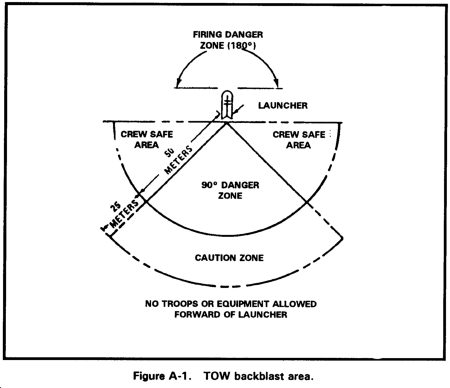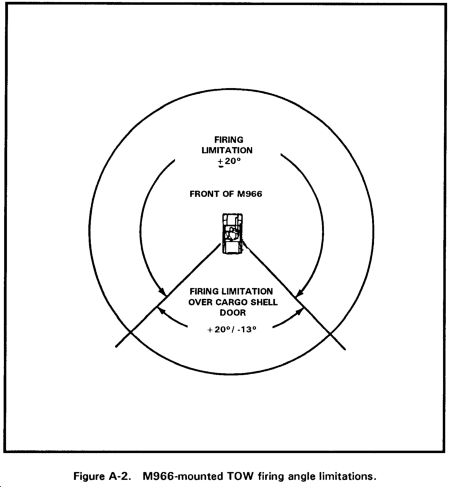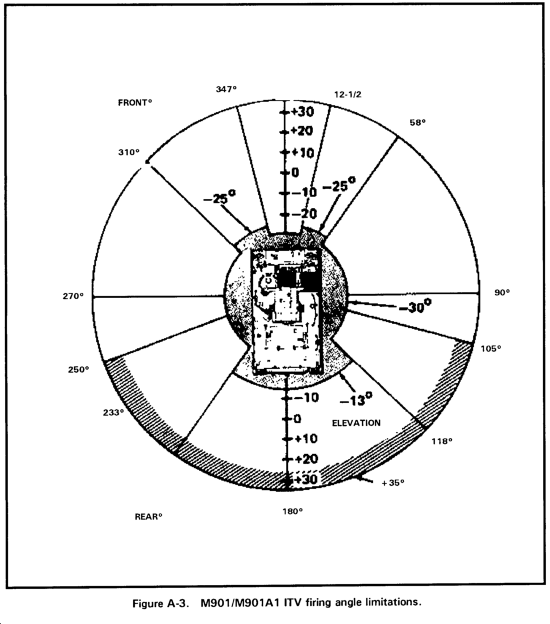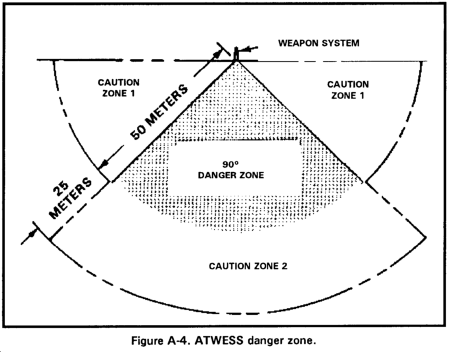APPENDIX A
SAFETY
Units should develop local directives and SOPs. SOPs should include individual responsibilities, safety requirements, proximity limits for personnel and explosives, location and sequence of operations, equipment required for handling munitions, and protection for troops. Individual responsibility for operations involving explosives must be designated. Troops must not tamper with the encased missiles other than to remove the forward handling ring.
Because of the danger to troops from the backblast, extreme care must be used in all phases of training. Emphasize this danger from the first stage of training. Conduct all crew tasks, position and tracking exercises, and firings with the simulation round as though missiles were being fired.
A-1. SAFETY PRECAUTIONS
The TOW backblast area extends 75 meters to the rear of the launcher and forms a 90-degree danger area. It is divided into a danger zone and a caution zone.
a. The danger zone extends 50 meters to the rear of the launcher. In this zone, serious casualties or fatalities are likely to occur from the blast and flying debris.
b. The caution zone extends an additional 25 meters to the rear of the danger zone. In this zone, a soldier is safe provided he does not face the aft end of the launcher. During training, the caution zone must be clear (Figure A-1). (For further information on TOW firing limitations, see Chapter 2.)
|
WARNING All crew members must wear V-51R (or equivalent) earplugs that have been fitted by qualified medical personnel. Failure to use the proper earplugs during missile firing could cause serious injury. |
c. The surface danger zone for any firing range consists of a firing area, a target area, impact area, and danger areas surrounding these locations. An additional area for occupation by personnel during firings may also be required. The shape and size of the surface danger zone varies with the type of missile or rocket being fired. (Refer to AR 385-62 for dimensions.)
|
WARNING When firing the TOW from confined spaces, such as dugouts or rooms, the gunner must be aware that structural damage to the enclosure may occur and occupants might be injured by flying debris. Severe concussion and concentration of toxic gases may result. There is also a danger of starting fires. |
d. In accordance with AR 385-62, C1, 5 Jan 77; Chapter 1, paragraphs 1 through 4; and Chapter 6, paragraph 6-11, TOWs will not be fired from buildings, bunkers, or within 100 meters of a vertical or nearly vertical backstop without the approval of the commanding general.
A-2. MISSILE HANDLING PRECAUTIONS
Improper handling of the encased missile may damage the components and cause malfunctions when the missile is launched. If the encased missile is dropped, the end handling rings and the launch container may be damaged. If the missile has been damaged or there is damage to the launch container (other than minor deformation of handling rings), the encased missile should be returned to the ammunition unit for inspection and disposition.
A-3. SIGHTING AND AIMING PRECAUTIONS
Gunners must not look at the sun or bright lights while sighting through the daysight tracker; serious eye burn could result. They must not look through the daysight tracker at an air field test set on the control tower unless the distance between the daysight tracker and the test set is more than 300 feet.
A-4. FIRING ANGLE LIMITATIONS
Azimuth and elevation firing angles are limited by the traversing unit, the vehicle, and other external restrictions. All elevation angles are referenced to the horizontal plane of the traversing unit. All azimuth angles are referenced to the long axis of the vehicle and depend on whether the launch tube points over the front or rear of the vehicle. The other reference line is the line-of-sight from the TOW to the target.
|
WARNING At angles greater than 20 degrees above ground level, hazards to the gunner may exist in the overpressure waves and debris caused by the backblast during training. Do not use angles greater than 20 degrees. |
a. When the TOW is tripod-mounted, a 360-degree lateral track is possible, because the traversing unit is not restricted in azimuth. Mechanical stops limit the elevation angle coverage to 20 degrees below and 30 degrees above the horizontal plane. Before the missile is fired, the line-of-sight angle should be estimated at the expected time of launch and throughout the expected missile flight time. The firing position should be changed or a different target selected if an expected line-of-sight angle exceeds the firing limitation angle.
b. The firing angle limitations of the TOW carriers are as shown in Figures A-2 and A-3.
A-5. SAFETY PRECAUTIONS FOR MILES
The gunner must follow these safety precautions:
a. Do not load an ATWESS cartridge until ready to fire. If the target is lost, remove the ATWESS cartridge from the firing chamber before moving.
b. Before pulling the PULL-TO-ARM switch, always check to ensure there are no personnel in the ATWESS danger zone. This zone extends for 75 meters behind the ATWESS firing chamber and covers an arc 90 degrees wide (Figure A-4).
c. Never view the laser being fired through stabilized optics, such as binoculars or telescopic weapon sights, when within 75 meters of the transmitter.
A-6. SAFETY PRECAUTIONS FOR THE TOW GUNNERY TRAINER
The following safety precautions must be observed when using the TGT.
|
DANGER This equipment uses high voltage to operate. Never use ungrounded extension cords, ungrounded adapters, or any ungrounded outlet to connect the TGT. Death on contact may result if personnel fail to observe safety precautions. |
a. Use two people to lift the instructor console. The console is heavy and lifting with only one man could result in serious injury.
b. Do not attempt to open shipping cases before pressing air pressure release valves on side of cases. Serious injury to personnel could result from opening cases with high pressure inside.
c. Turn off the power to the TGT trainer and disconnect the wall outlet plug before beginning cleaning procedures.
A-7. SAFETY PRECAUTIONS FOR THE TOW FIELD TACTICAL TRAINER
The following safety precautions must be observed when using the TFTT.
a. The laser light emitted by the TFTT is considered eye safe, but suitable precautions must be taken to avoid possible eye damage from overexposure to this radiated energy. The preface to TM 9-6920-453-10, the laser range safety procedures in AR-385-63, and TB MED-279 discuss these precautions.
b. The M80 blast simulator used with the TFTT can cause death or injury. Observe the precautions listed in the preface of TM 9-6920-453-10.
c. To avoid personnel injury and equipment damage, four people are needed to lift and carry each shipping container.
The following safety precautions must be observed when using the TGT.
|
This equipment uses high voltage to operate. Death on contact may result if personnel fail to observe the safety precautions listed in TM 9-6920-453-10. |
|
NEWSLETTER
|
| Join the GlobalSecurity.org mailing list |
|
|
|





